About Woodhall Spa
Woodhall Spa began by accident!
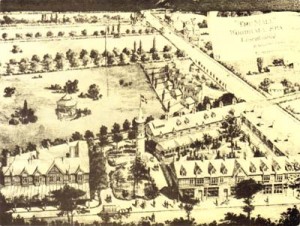
Fig 1- Richard Adolphus Came's vision
Mr. John Parkinson was one of several entrepreneurs in the early decades of the 19th century who, unsuccessfully, searched for coal in the area. However, after his mine was closed, water escaping from the shaft was found to be beneficial to the health of both animals and people.
Consequently, the local Lord of the Manor, Mr. Thomas Hotchkin, built a small bathhouse, then a hotel and what was to become the famous “Iodine Spa” was born. For half a century from the late 1830s, the Hotchkin family maintained, developed and modernised the increasingly popular spa baths and hotel.
Then, in the late 1880s, the enterprise was sold to a “Syndicate of Gentlemen” and a London architect, Mr. Richard Adolphus Came, was employed; he designed the Broadway and wide tree - lined avenues of the village, which still remain today.
A Planned Community
Woodhall Spa is unique in Lincolnshire, having more in common in its history and ambience with Spa towns like Harrogate, than with the traditional market towns and rural villages of the county.
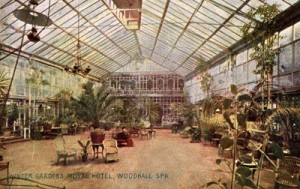
Photo 1 - Royal Hotel Winter Gardens (Postcard in Webmaster's collection)
From the start, the architect commissioned to create the Spa, Richard Adolphus Came, had a vision of his own - an elegant and spacious community in a woodland setting, with broad tree-lined avenues and large residential plots. This is still percieved as one of our greatest assets - 'the space is the place' is an often quoted observation. To achieve it, Mr Came created a stringent set of design and planning guidelines, even specifying that Woodhall Spa should not have 'streets', a policy maintained today.
At the heart of this new community were the Pinewoods and Spa Baths, now semi derelict, the luxurious Victoria Hotel nearby, (the site of the Coronation Hall) which burnt down on Easter Day 1920 and the Royal Hotel and Winter Gardens (where Royal Square is today), which was destroyed by a parachute aerial mine in 1943. There were many other smaller hotels and boarding houses to accommodate the visitors who flocked to take the waters, arriving at Woodhall Junction, which had direct links to London, and travelling into the second station in the centre of the Spa on the Horncastle branch line.
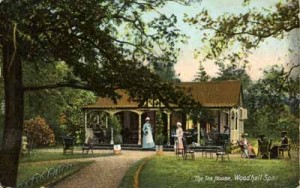
Photo 2 - The Tea House in the Woods ( Postcard in the Administrator's collection)
A Fashionable Resort
In its Edwardian heyday, the cream of society, including royalty, visited Woodhall Spa. Accordingly the community enjoyed many more facilities than would normally be expected in a village of its size - still the case today. Distinguished guests at the Victoria Hotel would be seen before dinner in full evening dress strolling through woods hung with Chinese lanterns , there was even a regular visitor list printed.
Although the Spa became a less fashionable destination after the First World War, the community continued to prosper in a quiet way as both an elegant leisure destination and a centre for healing. The internationally famous Golf Course was redesigned by Colonel SV Hotchkin MC and CK Hutchison in the 1920's and has since remained virtually unaltered. It is a world ranking Championship course and a few years ago was voted the 'Best Inland Golf Course' by Golf World magazine. In 1995 it was purchased by the English Golf Union, who built their HQ in the grounds and added a second golf course.
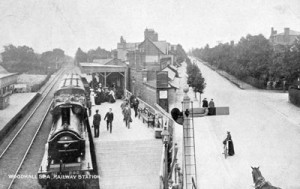
Photo 3 - Woodhall Spa Railway Station (Postcard in the Administrator's collection
During the Second World War the Spa took on the atmosphere of a garrison town, recording more air raid warnings than Lincoln. The streets rang to the sound of marching feet as regiments from across Britain disembarked at the Junction and marched down the Witham Road to billets in the large houses and hotels or the camps on Kirkby Lane. Armed guards surrounded the pinewoods where edwardian aristocrats used to walk and where equipment and ammunition were now stored. Paratroopers went directly from the Spa to Arnhem and came directly back here from the battlefield. The RAF used the Petwood Hotel as an officer's mess, most famously for the 617 'Dambuster' Squadron. At the end of the war, as the British troops left, thousands of Polish troops arrived, continuing the cosmopolitan experience.through the next 30 years, Woodhall Spa evolved to its current role as a conference, leisure and social centre for the county and beyond, with its range of hotels, restaurants, shops, pubs and the many sporting, and social clubs. The Woodhall Spa Agricultural Show ran for more than 50 years, in its heyday second only to the county show in popularity. As car use grew, cuts in railways saw the Horncastle branch line, which ran through the centre of the Spa, close, followed by Woodhall Junction in 1970 when the Lincoln to Boston line along the River Witham was closed too.
Until 1974, Woodhall Spa had its own urban District Council and remained very much in control of its own fate, determining the style and type of developments, maintaining its own tree-lined avenues and developing the park and other public spaces.
With local government re-organisation, the Urban District Council ceased to exist to be replaced by a Parish Council. Whilst surrounding villages rejoiced in the new powers of parish councils, Woodhall Spa had the opposite experience. Planning control and the running of Jubilee Park, road and tree maintenance and other powers passed to the new District and County Councils, a loss keenly felt to this day.

Fig 2 - Railway poster from the 1930's
It was from the early 1970s that Woodhall Spa began to see a more concerted house building programme in its Woodlands - Arnhem Way and Woodland Drive were built and houses were added to infill the existing avenues and road. As pressure to protect the remaining woods and the special character and heritage of the Spa led to the creation of the Cottage Museum, the designation of the Conservation Area and the first village plan in 1988, with the help and support of a planning officer at the District Council.
The Village Plan, and its successor District Plan, has seen many old properties tastefully renovated and new developments in the centre of the Spa that have enhanced and enlivened the village.
New Pressures
Woodhall Spa has always thrived on a steady influx of new residents. However, the recent growth in the rate of house and flat construction, mostly in the executive category and promoted heavily in the south-east of England, is clearly seen by residents as a threat to the maintenance of a balanced, inclusive and sustainable community. It is also perceived as having the potential to destroy the essential design features and unique Spa resort ambience that has been at the heart of Woodhall Spa's enduring attraction.
The pressure on services, traffic issues and questions over the former Spa Baths and the future development of Jubilee Park have all added to the feeling of a village under threat, a feeling which is reflected in the high response rate to the Parish Plan Questionnaire and the attendance rate at public meetings on these issues over the past couple of years.
Some preconceptions need to be challenged; often Woodhall Spa is considered to be a wealthy village and although it is true that many are comfortable there are a large number who are not wealthy and could be penalized by this way of thinking. The parish needs as much help as the next including financial support for projects and investment to ensure future success.
The Parish Plan is Woodhall Spa's way of showing all those in a position to influence the development of our community what aspects we most value, what changes we would like to see and what we want to avoid. It highlights the shared responsibility of all agencies in helping us to achieve this blueprint for our future.
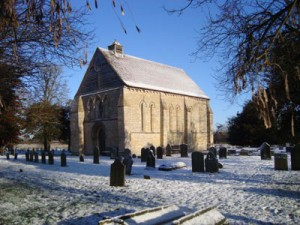
St Leonard's Church
Addendum
In the early 1980's Woodhall Spa absorbed the ancient parish of Kirkstead, which brought with it the ruin of the great Cistercian Kirkstead Abbey and the 13th Century St Leonard's Church. These and the medieval Tower on the Moor, Woodhall Spa's symbol, are the tangible reminder of the history of the area before the Spa was born. There are also records of Iron Age finds and evidence of even earlier settlements.
Heritage
Local aviation heritage has its own dedicated page, covering the Dambusters/Woodhall Spa link and local aviation heritage centres
The local Cottage Museum houses a changing display of the history of the village. If you would like to know more about the history of Woodhall Spa then why not visit the museum at the:
The Bungalow
Iddesleigh Road
Woodhall Spa
Telephone: 01526 353775
Or follow the Woodhall Spa Heritage Trail below
Heritage Trail locations
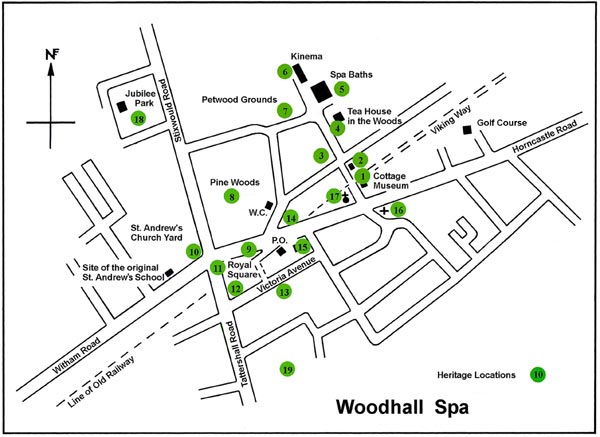
The trail can be started at any location, but we suggest you also visit the Cottage Museum to see the photographs taken by John Wield during the heyday of the Spa and items associated with this unique Victorian Spa town.
The Trail is just one of several projects in the hands of the Woodhall Spa Parish Council sponsored Heritage Committee.
How well do you know Woodhall Spa?
See if you can identify the location of these architectural features and items of street furniture! Or find the Letterbox (coming soon)
Find out more about the Woodhall Spa Conservation Area
Further Reading
| Title | Author | Publisher | Year | ISBN |
|---|---|---|---|---|
| The Book of Horncastle & Woodhall Spa | David N Robinson | Barracuda Books Ltd | 1983 | 0 86023 187 9 |
| The Horncastle & Woodhall Junction Railway | A.J.Ludlam | The Oakwood Press | 1986 | 0 85361 326 5 |
| Woodhall Spa on old picture postcards | Brian & Shirley Prince | Reflections of a Bygone Age | 1992 | 0 946245 56 8 |
| The Lincolnshire Loop Line (GNR) and the River Witham | A.J.Ludlam | The Oakwood Press | 1995 | 0 85361 464 4 |
| A Century of Golf at Woodhall Spa | Margorie Sargeant | Richard Kaye Publications | 2000 | 1 902882 42 3 |
| The Kinema in the Woods - The Story of Woodhall Spa's Unique Cinema | Edward Mayor | J.W Green Cinemas | 2002 | 0 9543037 0 9 |
| Voices of Woodhall Spa - A Century of Memories | Margorie Sargeant | Woodhall Spa Cottage Museum | 2003 | 0 9546443 01 |
| Petwood, The remarkable story of a famous Lincolnshire Hotel | Edward Mayor | A Petwood Publication | 2004 | |
| Woodhall Spa & The World. 1885-1890 in the "NEWS" | Marjorie Sargeant | Woodhall Spa Cottage Museum | 2006 | 0 9546443 1 X |
| Echoes of Woodhall Spa - Woodhall and War | Marjorie Sargeant | Woodhall Spa Cottage Museum | 2006 | 9546443-2-8 |
| The Woodhall Spa Guide | Edward Mayor | Silver River Books | 2007 | 9780955673009 |
| Woodhall Spa Past & Present | Marjorie Sargeant | Woodhall Spa Cottage Museum | 2008 | 0 9546443 3 6 |
| The Founding of Woodhall Spa - Myth and Reality | Edward Mayor | 2015 | ||
| The Gardens of Petwood | Nicholas Duke-Cox | Woodhall Spa Cottage Museum | 2017 | 0 954644395 |
| Taking the Waters at Woodhall Spa - History of the Spa Baths | Nicholas Duke-Cox | Woodhall Spa Cottage Museum | 2021 | 978-1-9161339-1-4 |
| Edwardian Days in Woodhall Spa | Marjorie Sargeant | Woodhall Spa Cottage Museum | 2021 | 978-1-9161339-2-1 |
Further Viewing
| Title | Producer | Publisher | Year |
|---|---|---|---|
| Why Woodhall Spa? | The Philip Groves Studio | Woodhall Spa Cottage Museum | 2009 |
| The Kinema in the Woods - The Story of England's Unique Cinema | Produced and directed by Richard Burn | Airship Productions | 2011 |
Why not take a short break in Woodhall Spa and uncover the village heritage for yourself?
The village has a fine selection of hotels, guest houses and camping/caravanning sites. Select the accommodation page for more information.
Visit the Tourism pages to learn more about local heritage sites